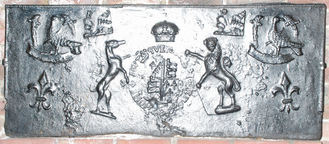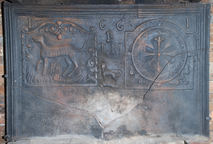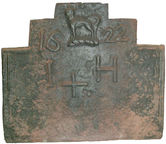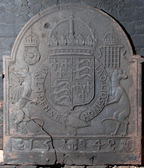-
10
Description: Rectangular; rope edging (top and sides); central Tudor royal shield with encircling garter (motto reversed: HONE SOVT QVEY … PEN), separate greyhound and lion supporters, separate crown; a bird, repeated in each top corner, its wings displayed and inverted and its head facing behind and to the left, standing on a scroll; a fleur de lys repeated in the bottom corners; inside the birds is a repeated stamp, half of one similar to a stamp on a fireback in Hastings Museum.
Notes: The particular form of the Tudor arms and supporters is encountered on other firebacks, as are the distinctive style of fleurs de lys and the birds (probably swans, a Lancastrian icon). The plain scroll upon which the bird is perched suggests that there might have been a painted inscription on it originally and that the stamp had not been made specifically for the decoration of firebacks but was, perhaps, redundant from interior domestic decoration. Formerly at Framfield, East Sussex.
Arms: Tudor royal (prob. Henry VIII)
- Decoration tags:
- rectangular (shape)
- rope (edging)
- carved stamps
- heraldic
- armorial
- royal
- objects
Manufactured: in the early- to mid-16th century possibly at Pounsley Furnace, Framfield in the Weald area of England.
Current location: The Clergy House, Alfriston, East Sussex, England.
Museum number: 200044 (part of the National Trust museum group)
-
13
Description: Rectangular; composite: complex (cavetto/cyma recta/ovolo) moulded edging (top and sides), derived from domestic carpentry; two firebacks used as patterns: on the left, rectangular with mirrored floriate scrolled top, simulated overlapping tile edging at sides, with fillet bottom edge, a mythical salamander in the form of a dog with an arrow-shaped tongue, standing among flames, a stapled scroll inside the left and right edges; on the right, arched rectangular with fillet edging indented on the inner side, surrounding a circular clock face with Roman numerals, each interspaced with a bead, and a button outside each quarter, a triangular design of swirled foliage in each bottom spandrel; initials in triad between firebacks; below, stamp formed of a talbot statant guardant upon a wreath; date split: ‘1’s in top corners, ‘6’s above initials; bottom third of fireback plain.
Notes: The talbot crest, which in this instance has been over pressed and shows the shape of the backing, is seen on other firebacks indicating a common source; the 'salamander' fireback (see no. 851) is one of the Stapled Scroll series; composite firebacks (where the impression of one or more other firebacks are used as part of the decoration) are uncommon in England but less so in France.
Inscription: 16 61 / IBM [triad]
- Decoration tags:
- rectangular (shape)
- complex, furniture-derived (edging)
- composite
- individual letters
- individual numbers
- heraldic
- mythological
- text
- animals
- objects
Manufactured: in 1661 in the Weald area of England.
Current location: in private hands, Ardingly, West Sussex, England.
- Attached to series:
- Composite firebacks
- Talbot crest series
-
603
Description: Arched rectangular shaped, the arch linked to the rectangle by cavetto curves; cavetto edging ending in two opposed spirals at top; initials below spirals; date below initials; otherwise plain.
Notes: Probably cast from a carved, edged board, with the initials and date added separately. A copy.
Copies of this fireback are known.
Inscription: IH / 1678
- Decoration tags:
- rectangular with round arch (shape)
- cavetto (edging)
- individual letters
- individual numbers
- text
Manufactured: in 1678 in the Weald area of England.
Current location: Banbury, Oxfordshire, England.
- Attached to series:
- Small arch series
-
200
Description: Composite; rectangular with semi-circular arches in middle (large) and ends (small) of top edge; rope on all edges except bottom; central panel effectively comprises an arched fireback form with Tudor royal arms (temp. Elizabeth I) with date above, and, below, letters G M, made from rope with fleur de lys terminals between two coronets surmounted by lions; below this are fronds with roses. On either side of this panel are placed the Anne Forster inscription panels; above each of these is a rose and crown with lion and dragon supporters, beneath which are three fleurs de lys. Along the base of the inscription panels and the central panel are single rows of ‘grape bunch’ shapes, beneath which are repeated trailing vine decoration from impressed wooden strips across the entire width of the fireback; 35 in all.
Notes: Formerly at Baynard's Park, Ewhurst, Surrey; GM probably refers to Sir George More, who built Baynards Park after buying the estate in 1587, and who moved to Loseley in 1604. The central coat of arms has been noted on two other firebacks, dated 1588 (no. 41) and 1595 (no. 482). The rose and crown stamps have been noted on a fireback in Haslemere Museum, and on examples illustrated by Lower (all of which bear the date 1582 and the initials IA; e.g. no. 107 or no. 472). The association of these stamps and the particular form of rope lettering, with the Anne Forster inscription and the ‘grape bunch’ shapes, both of which have been linked with other stamps from Pounsley furnace, suggests that they, too, were part of the stock of those works.
Inscription: 15 93 / GM / HER : LIETH : ANE : FORST/ R : DAVGHTER : AND : / HEYR : TO : THOMAS : / GAYNSFORD : ESQVIER / DECEASED : XVIII : OF: / IANVARI : 1591 : LEAVYNG / BEHIND : HER II : SONES : / AND : V : DAVGHTERS [twice]
Arms: Tudor royal
- Decoration tags:
- rectangular with three arches (shape)
- rope (edging)
- simple stamps
- carved stamps
- carved pattern panels
- individual letters
- individual numbers
- planklines
- heraldic
- armorial
- royal
- text
Manufactured: in 1593 possibly at Pounsley Furnace, Framfield in the Weald area of England.
Current location: not known.
Citation: Manning, O. & Bray, W., 1809, History of Surrey Vol. II (London, John White), p. 369n.
-
201
Description: Rectangular; moulded fillet edging on top and sides; TCI, also arranged symmetrically, in a widely spaced triad; below, symmetrical layout of central rose and crown between two concentric roundels, with two fleurs-de-lys outside.
Notes: The style of rose and crown is similar to that used in gun founding in the Tudor period, suggesting that the furnace that was the source of this fireback may have been used for that purpose. Formerly at Baynards Park, Cranleigh, Surrey.
Inscription: 16 T C I [triad] 70
- Decoration tags:
- rectangular (shape)
- complex, furniture-derived (edging)
- carved stamps
- individual letters
- individual numbers
- heraldic
- royal
- text
Manufactured: in 1670 in the Weald area of England.
Current location: not known.
- Attached to series:
- 1660s-90s Wealden series
-
277
Description: Arched rectangular with cavetto-moulding along top, supported by Ionic pilasters; English Stuart royal shield, garter, helm, crown, motto and supporters; date below and either side of garter.
Notes: One of several firebacks, all of the same date, but varying in size, framing style and moulding; all have stylistic features in common and will have been the work of the same pattern maker, who was also responsible for carving royal coats of arms in three West Country churches. Mendip Auctions, Binegar, 11 Dec 2021, lot 537. Copies of this fireback were advertised in Bratt Colbran Ltd.'s (London) catalogue in the early-20th century.
Copies of this fireback are known.
Inscription: I R [Jacobus Rex] / HONI SOIT QVI MAL Y PENSE / 16 18 / DIEV ET MON DROIT
Arms: English Stuart royal (James I)
- Decoration tags:
- rectangular with round arch (shape)
- complex individual (edging)
- whole carved pattern
- architectural
- armorial
- royal
- text
Manufactured: in 1618 possibly in the Forest of Dean area of England.
Current location: not known.
-
204
Description: Canted rectangle; twisted rope edging (top and sides); Tudor royal shield and Garter with crown above, between lion and unicorn supporters; initials separated by crown; a small ring and bar are placed to the left of the unicorn’s mouth.
Notes: The Tudor shield and crown feature on many Wealden firebacks, and have here been reused with Jacobean supporters; their stamps are derived from standing models.
Inscription: I R
Arms: Tudor royal
- Decoration tags:
- rectangular with canted top corners (shape)
- rope (edging)
- carved stamps
- individual letters
- heraldic
- armorial
- royal
Manufactured: in the early-17th century possibly at Pounsley Furnace, Framfield in the Weald area of England.
Current location: St Mary's Abbey, Blanchland, Northumberland, England.
- Attached to series:
- Pounsley series
- Jacobean royal armorial firebacks
-
206
Description: Rectangular with two-stepped top; double astragal edging on sides; top centre, stamp formed of a talbot statant guardant upon a wreath; date split either side of crest; initials below date, ‘+’ below letters.
Notes: The talbot crest is seen on other firebacks indicating a common source.
Copies of this fireback are known.
Inscription: 16 22 / I + H
- Decoration tags:
- stepped (shape)
- fillet (edging)
- simple stamps
- carved stamps
- individual numbers
- heraldic
- text
Manufactured: in 1622 in the Weald area of England.
Current location: St Mary's House, Bramber, West Sussex, England.
- Attached to series:
- Talbot crest series
- Stepped firebacks
-
207
Description: Arched rectangular shape; ovolo-moulded edge; Tudor royal shield, crown, garter and supporters (dragon and greyhound). Crowned rose on left, and crowned portcullis (grid of 16) on right side of crown; the supporters stand on a horizontal fillet; date panel with ovolo-moulding on top, central putto face splitting two parts of date with faces of putti in profile at each end.
Notes: Arms are of Edward VI. A very clear casting, almost certainly from the original pattern. There are several firebacks with the Tudor royal arms that were probably produced in the Spanish Netherlands, perhaps illustrating the association between England and Spain through the marriage of Henry VIII and Katherine of Aragon. The firebacks differ in several small details, such as the form and rotation of the Garter motto, the style of the crown, the positioning of the supporters in relation to the Garter, and the form and size of the crowned rose and portcullis.
Copies of this fireback are known.
Inscription: HONI SOIT QVI MAL I PENSE / 15 48
Arms: Tudor royal Edward VI
- Decoration tags:
- rectangular with round arch (shape)
- fillet (edging)
- whole carved pattern
- planklines
- heraldic
- armorial
- royal
- text
Manufactured: in 1548 possibly at Eisenschmitt Furnace in the Eifel area of Germany.
Current location: Ockwells Manor, Cox Green, Berkshire, England.
Citation: Kippenberger, A. 1973, Die Kunst der Ofenplatten (Düsseldorf, Verlag Stahleisen), p. 107.
-
208
Description: Canted rectangle; twisted rope edging (top and sides); quasi-symmetrical arrangement of four fleurs-de-lys in star, top centre, two fleurs each side along top edge, single fleurs beneath outer top fleurs; short rope length in vertical and inverted 'V' shapes each side between top fleurs; ?dagger handle irregularly positioned centre left and right.
Notes: The style and shape of the fleurs-de-lys is unique to a particular series of firebacks, suggesting the same source; the 'V' shapes may have apotropaic significance. A sketch of this fireback c.1891 is in the collection of J. Starkie Gardner's sketch books at the Victoria and Albert Museum, Archive of Art and Design (AAD/2014/8); at the time of drawing it was stated to be in the ownership of one Simmons, a furniture dealer of Lewes.
- Decoration tags:
- rectangular with canted top corners (shape)
- rope (edging)
- simple stamps
- carved stamps
- heraldic
Manufactured: in the mid-16th century in the Weald area of England.
Current location: in private hands, Cox Green, Berkshire, England.
- Attached to series:
- Royal series









